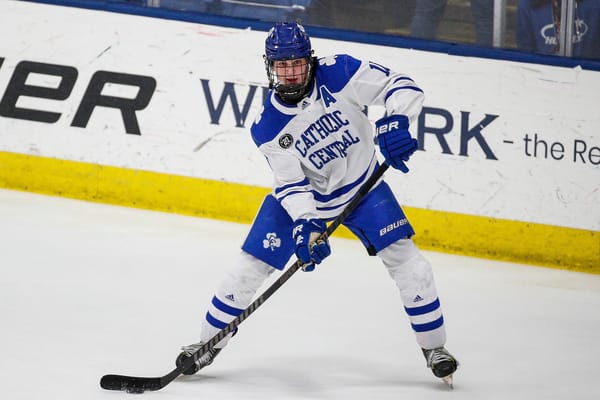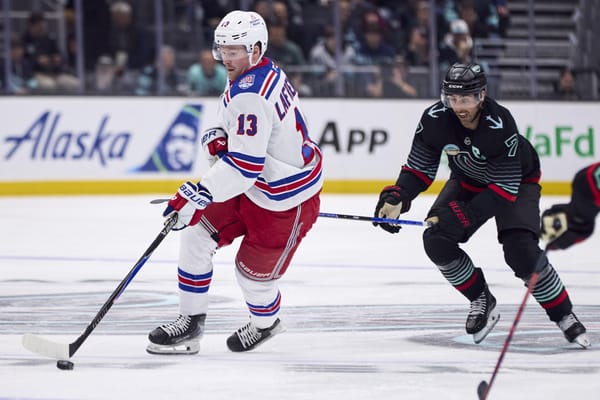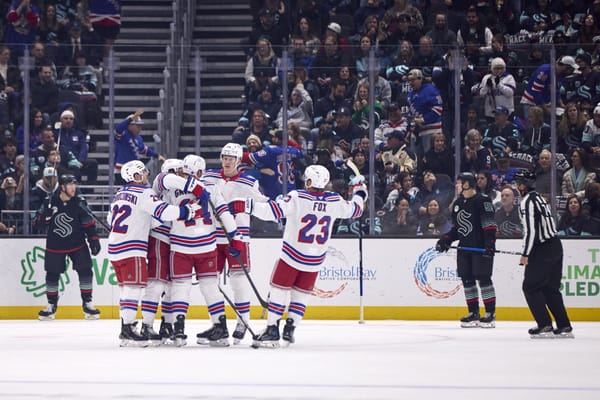Why The Best Choice for Second-Line Center Could be Vlad Namestnikov
Left with a massive hole and no obvious solutions, Vlad Namestnikov may be the temporary answer.
“We probably have the most opportunistic camp in the National Hockey League right now,” was a thought that Head Coach David Quinn reiterated following the Rangers’ preseason defeat to the Flyers on Saturday.
No situation better represents that than the competition at center. Mika Zibanejad will line up on the team’s top-line; that much is certain. Beyond that, it’s anybody’s guess. There are at least seven different players in camp who could end up filling one of the three remaining center positions available in the lineup. Quinn and his staff have a massive decision to make on whom to name the team’s second-line center. Could the answer be someone who is flying under the radar, Vlad Namestnikov?
No doubt, the favorite for the job should be Filip Chytil. In a vacuum, the Czech youngster is by far the most talented option available. There were times last season where he looked the part and many more times when he did not. Quite often, Quinn felt that Chytil’s best position was on the wing. At times, the responsibility of center seemed to overwhelm the teenage Chytil and the move to wing alleviated the burden.
Chytil’s 23 points in 75 games last season don’t scream top-six capability, but the jump from 19 years old to 20 is a massive one in terms of development. He’s going to be quicker and stronger. He has a much better understanding for the NHL game now and has a full year under Quinn’s system to his name. There’s going to be less learning on the job this year. Not to mention that a top-six spot on this year’s team means playing with significantly more talented players than he was often stuck with on last year’s talent-devoid squad. It’s also fair to wonder if the drag of his first lengthy NHL season plus the team’s deadline purge took a toll; Chytil produced a very respectable 18 points in 47 games prior to the All-Star break before crashing in the second half. For what it’s worth, The Athletic’s Dom Luszczyszyn projects that Chytil will register 16 goals and 21 assists over 70 games. That certainly wouldn’t make him a marquee second-line NHL center in 2019-20 but certainly passable enough given the Rangers’ circumstances.
Suppose Chytil is not the answer, though. Or, suppose the coaching staff decides that, while Chytil’s time may come later in the season, October is too soon.
In an ideal world, the Rangers would love for Lias Andersson or Brett Howden to pull away with the job. Their top-six upside is debatable long-term. For 2019-20? Forget it. Andersson has had a nice training camp, but still has work to do to establish himself as a bonafide NHLer in any capacity. As for Howden, he may have the offense to pass for a second-line center, but he may very well have been the worst defensive center in the entire NHL last season. Quite frankly, this is a player who may be best served playing top-six minutes in Hartford to start the year. At best, he needs sheltered minutes with the Rangers.
On the surface, Ryan Strome may seem like the solution. The former fifth-overall pick bagged 18 goals along with 15 assists in 63 games with the Rangers last season. That’s certainly competent second-line production. A more thorough analysis of Strome’s season indicates his scoring was fool’s gold. For starters, 21 of his 33 points with the Rangers came on the power play. Power play production is nice, but shouldn’t hold much weight when analyzing a player’s potential influence at five-on-five. Furthermore, Strome was the beneficiary of a healthy dose of puck luck. Per Evolving-Hockey, Strome was expected to score only 10.92 goals based on the quality of his shooting opportunities. Take away the scoring, and there’s not much else to speak of as Strome is not a driver of play. He’s merely okay at carrying and passing the puck. His defensive play last season was very poor, as indicated by Hockey Viz (red indicates high shot volume).
All of which is why the de facto solution to this conundrum may very well be Namestnikov. He hasn’t lived up to expectations when the Rangers acquired him in the blockbuster deal with Tampa Bay, nor has he justified his $4 million cap hit. There’s no undoing the past, but maybe there is an opportunity to make the best of the situation.
Namestnikov does not fit the mold of a traditional top-six center. He isn’t very skilled on the puck. Ignore the 2017-18 season where he seemingly won a radio contest and ended up on a line with Steven Stamkos and Nikita Kucherov, and Namestnikov’s career-high sits at 35 points.
However, Namestnikov is an elite player between the margins. He’s one of the top defensive centers in the NHL, doing a lot of great things to suppress shots. He swallows up space in the neutral zone, forcing dump-ins or altogether stalling play at center ice. In the defensive zone, he patrols the slot with tremendous aptitude, timing his coverages well and tying up sticks at the right moments.
While he’s not effectual at making plays in the offensive zone, he does drive play. He has a positive penalty differential, drawing 58 minors while taking just 50 since the 2014-2015 campaign. Corey Sznajder’s tracking has found Namestnikov to be a catalyst for zone exits and zone entries.
Yes, Namestnikov clearly stuck out like a sore thumb on a line with Stamkos and Kucherov. Also recognize that, on a supremely loaded team like Tampa Bay, there’s a reason why Head Coach Jon Cooper picked him of all their talented forwards to play on that line. Namestnikov has limited talent in the offensive end of the rink, but he did a lot of the laborious duties which gave those two more freedom to optimize their offensive talents.
Chris Kreider and Kaapo Kakko are not at that level, but the dynamic is similar. Those two are the ones you want pushing the play in the offensive zone. Namestnikov can do the work to create those opportunities for them as well as provide a defensive buffer. In particular, Kakko is going to have major responsibilities thrust upon him as an unfledged 18-year-old. Anchoring him to a veteran center with the ability to clean up messes and do sophisticated work in vulnerable situations could go a long way towards easing his transition.
That also trickles down to the aforementioned young centers. Namestnikov eating difficult minutes would create a situation in which Quinn would be able to provide more sheltered, manageable shifts in the bottom-six to whoever makes the roster of Chytil, Howden, and Andersson.
Not to mention that, if this season goes as expected, the Rangers seem likely to be deadline sellers yet again. Namestnikov is an unrestricted free agent next July and would be an obvious trade candidate. It wouldn’t hurt to put him in a position to show his best self and heighten his value.
Namestnikov is far from the quintessential second-line center, but the Rangers have to work with what’s on the roster. Until someone else steps up and takes claim to the job, the dependable Russian may very well be the right pick to start the season.




